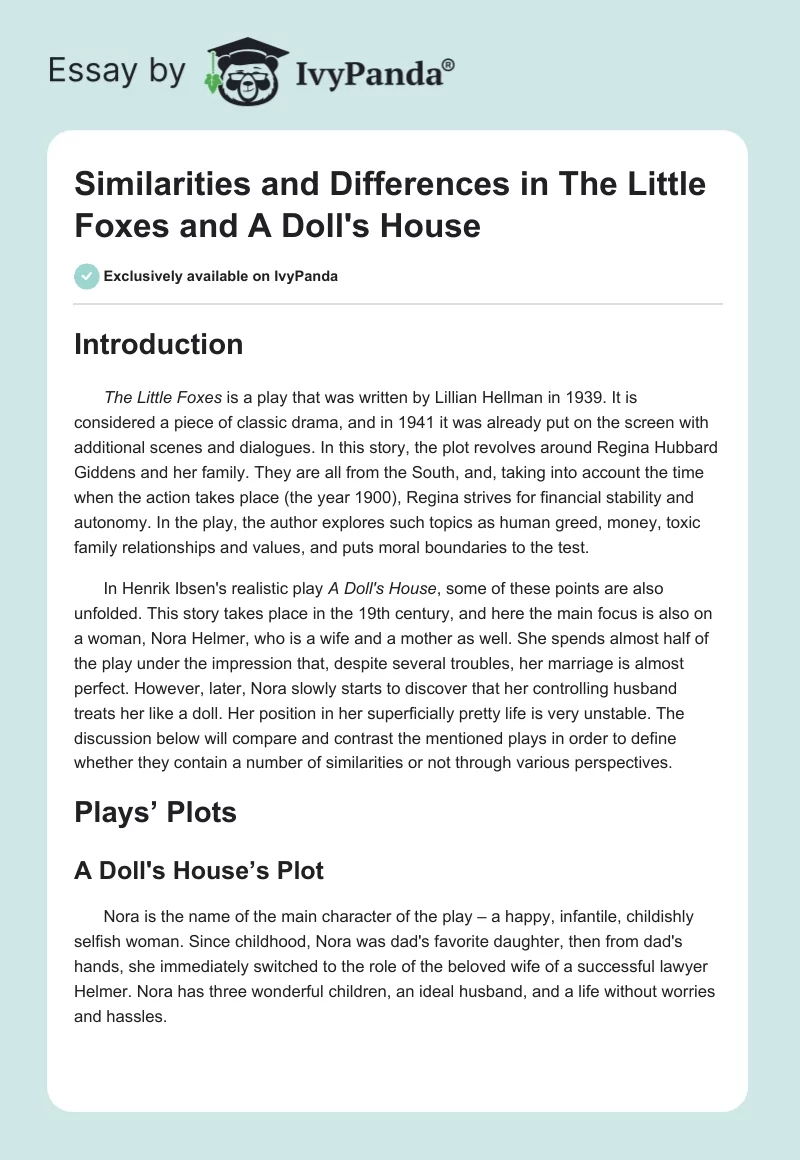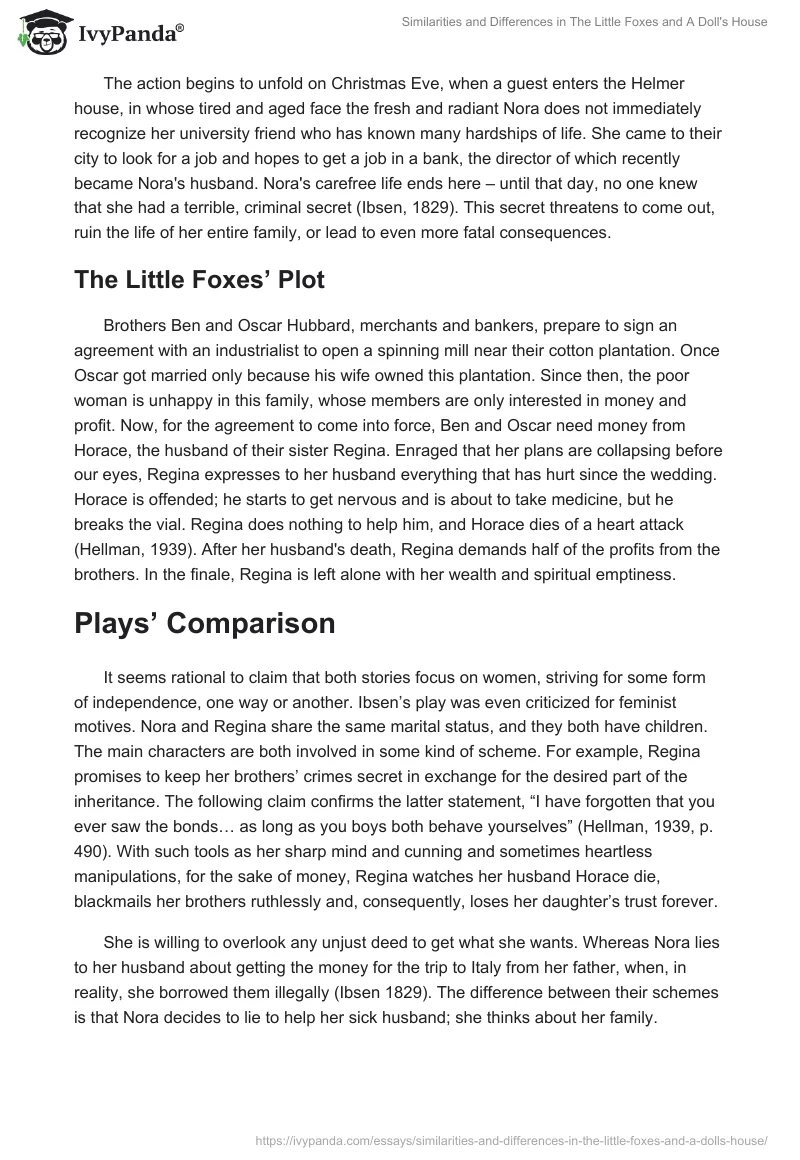Introduction
The Little Foxes is a play that was written by Lillian Hellman in 1939. It is considered a piece of classic drama, and in 1941 it was already put on the screen with additional scenes and dialogues. In this story, the plot revolves around Regina Hubbard Giddens and her family. They are all from the South, and, taking into account the time when the action takes place (the year 1900), Regina strives for financial stability and autonomy. In the play, the author explores such topics as human greed, money, toxic family relationships and values, and puts moral boundaries to the test.
In Henrik Ibsen’s realistic play A Doll’s House, some of these points are also unfolded. This story takes place in the 19th century, and here the main focus is also on a woman, Nora Helmer, who is a wife and a mother as well. She spends almost half of the play under the impression that, despite several troubles, her marriage is almost perfect. However, later, Nora slowly starts to discover that her controlling husband treats her like a doll. Her position in her superficially pretty life is very unstable. The discussion below will compare and contrast the mentioned plays in order to define whether they contain a number of similarities or not through various perspectives.
Plays’ Plots
A Doll’s House’s Plot
Nora is the name of the main character of the play – a happy, infantile, childishly selfish woman. Since childhood, Nora was dad’s favorite daughter, then from dad’s hands, she immediately switched to the role of the beloved wife of a successful lawyer Helmer. Nora has three wonderful children, an ideal husband, and a life without worries and hassles.
The action begins to unfold on Christmas Eve, when a guest enters the Helmer house, in whose tired and aged face the fresh and radiant Nora does not immediately recognize her university friend who has known many hardships of life. She came to their city to look for a job and hopes to get a job in a bank, the director of which recently became Nora’s husband. Nora’s carefree life ends here – until that day, no one knew that she had a terrible, criminal secret (Ibsen, 1829). This secret threatens to come out, ruin the life of her entire family, or lead to even more fatal consequences.
The Little Foxes’ Plot
Brothers Ben and Oscar Hubbard, merchants and bankers, prepare to sign an agreement with an industrialist to open a spinning mill near their cotton plantation. Once Oscar got married only because his wife owned this plantation. Since then, the poor woman is unhappy in this family, whose members are only interested in money and profit. Now, for the agreement to come into force, Ben and Oscar need money from Horace, the husband of their sister Regina. Enraged that her plans are collapsing before our eyes, Regina expresses to her husband everything that has hurt since the wedding. Horace is offended; he starts to get nervous and is about to take medicine, but he breaks the vial. Regina does nothing to help him, and Horace dies of a heart attack (Hellman, 1939). After her husband’s death, Regina demands half of the profits from the brothers. In the finale, Regina is left alone with her wealth and spiritual emptiness.
Plays’ Comparison
It seems rational to claim that both stories focus on women, striving for some form of independence, one way or another. Ibsen’s play was even criticized for feminist motives. Nora and Regina share the same marital status, and they both have children. The main characters are both involved in some kind of scheme. For example, Regina promises to keep her brothers’ crimes secret in exchange for the desired part of the inheritance. The following claim confirms the latter statement, “I have forgotten that you ever saw the bonds… as long as you boys both behave yourselves” (Hellman, 1939, p. 490). With such tools as her sharp mind and cunning and sometimes heartless manipulations, for the sake of money, Regina watches her husband Horace die, blackmails her brothers ruthlessly and, consequently, loses her daughter’s trust forever.
She is willing to overlook any unjust deed to get what she wants. Whereas Nora lies to her husband about getting the money for the trip to Italy from her father, when, in reality, she borrowed them illegally (Ibsen 1829). The difference between their schemes is that Nora decides to lie to help her sick husband; she thinks about her family.
Regina, on the other hand, gets involved in her foul play for herself, and she does not hesitate to step on people in the process. This turns out to be exactly why she is punished. Another similarity would be the fact that both main characters are left all alone in the end. Regina’s daughter abandons her, and Nora willingly leaves her so-called doll’s house, which she spent so much time decorating. Both characters obtain freedom and break free from the boundaries and clichés about what women are capable and incapable of, and they pay a high price for it.
Three is a crowd, they say, but another female figure cannot be ignored. It is Birdie, an aristocrat, and Oscar Hubbard’s wife. Her unhappiness forces her into excessive drinking; she is constantly ill-treated by her husband. Being the third of the siblings, he probably feels the lack of power in the family, which he takes out on his wife. Oscar married her because of her cotton farm and a large plantation. As a result, Birdie is seen more as an object rather than as a human being. The same parallel exists with Ibsen’s Nora, who realized that to her husband, she was a doll to be played with and admired (Ibsen, 1829). Such an objectifying makes another similarity between the two plays.
As for the main characters’ husbands, they both have power in their hands. However, Horace, who has a bad heart, looks weaker, as opposed to Torvald, who manages to improve his health with his wife’s help. Regina, in contrast, wants her husband to die sooner (Hellman, 1939). Before this happens, though, she cannot do much to take the situation into her hands. Just like Nora’s husband, who even fixes her dance steps, Horace controls the resource that his wife wants to obtain.
Here, it should be noticed that the wives are not the only ones being controlled and used in preconceived motives. In The Little Foxes, the children, specifically Leo and Alexandra, can be seen as foot soldiers in their parents’ war. The latter plan their steps wisely, and young people’s feelings do not even matter when the idea of Leo and Alexandra’s beneficial marriage arises. This expression confirms such an assumption, “You got to convince your Uncle Horace you going to make a fit husband for Alexandra” (Hellman, 1939, p. 449). Fortunately, this does not happen; however, Oscar’s son plays a mule role later when he is pushed to steal from Horace.
A similar attitude can be seen in Nora’s family, where she calls the children her dollies and later realizes that she only repeats her father’s fate and treats them like pretty little toys to play with (Ibsen, 1829). The difference between these arcs lies in the intentions. Adults in The Little Foxes manage their children like tools purposefully, whereas Nora does so without knowing. In the end, Regina seems to be apprehended when her daughter decides to leave her, but Nora does not look back, being sure that the little ones are in good hands.
Finally, both of these plays have very symbolic headlines, even though they are meant to attract attention to different issues. The name The Little Foxes comes from the Song of Solomon. The Hubbards have the necessary qualities to be associated with foxes; they are sly, witty, and prefer to act secretly. Such people only deserve to be called little, so this part is also fair. As for A Doll’s House, this name represents Nora’s illusions concerning her marriage, her relationships with her husband, and even childhood trauma.
Conclusion
To conclude, the above discussion shows that the two plays bear several similarities. The topics of toxic family relationships, control, and moral boundaries are explored in both plays. The main characters are women in search of control over their lives. Money also plays a huge role in both stories. However, the characters themselves are very different in their schemes and intentions. In the end, they are alone, but each of them reaches this point in different ways.
References
Hellman, L. (1939). The Little Foxes. In: L. Hartley & A. Ladu (Eds.), Patterns in modern drama: Ibsen, Chekhov, Galsworthy, O’Neill, Kelly, Thurber, Nugent, Hellman. Prentice-Hall.
Ibsen, H. (1829). A Doll’s House. T. Fisher Unwin.


